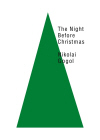The Night Before Christmas
Russian writer Nikolai Gogol is famous for his serious satiric novel The Overcoat, but The Night Before Christmas, originally published in a 1926 short story collection, was Gogol’s first work at age 27—an early contribution to Russian literature. Recognized then for its fine writing and humor, now it can also be appreciated as a charming picture of Ukrainian folklore. Instead of Scrooge or the Grinch, the devil and a witch make mischief on a night full of mystical forces, the night before Christmas.
Russian writer Nikolai Gogol is famous for his serious satiric novel The Overcoat, but The Night Before Christmas, originally published in a 1926 short story collection, was Gogol’s first work at age 27—an early contribution to Russian literature. Recognized then for its fine writing and humor, now it can also be appreciated as a charming picture of Ukrainian folklore. Instead of Scrooge or the Grinch, the devil and a witch make mischief on a night full of mystical forces, the night before Christmas.
Mischief must have darkness. On this beautiful moon and starlit night, the witch shows up first to “gather a whole sleeveful” of stars in her pocket. Then comes a wonderful portrait of the devil, starting with his appearance: a narrow face and legs so thin “he would certainly have broken them in the first Cossack dance,” a “tail as long and pointed as the uniform coattails of uniforms nowadays,” a “goat-beard under his chin,” little horns on his forehead, and finally “a behind no whiter than a chimney sweep’s.” He proceeds to seize “the moon with both hands, grimacing and blowing; he kept flinging it from one hand to the other, like a peasant who has picked up an ember for his pipe with bare fingers” and finally puts it in his pocket.
The conflicts of the story are first, the devil wants to be-devil Vakula, the pious blacksmith, for his painting of a church mural ridiculing the devil. Then comes relationship conflicts: Vakula is in love with beautiful, vain Oksana. Vakula’s mother, the witch Soloha, wants to marry Oksana’s rich father Tchub for his wealth. But in Russia, for both mother and son to marry into the same family would be considered incestuous.
Actually Soloha has many admirers among the prominent community men, a fact she hides from each of them. The complications develop in farcical fashion when she, in fact, has to hide them in coal sacks after each appears at her doorstep. These sacks fall into the hands first of the blacksmith and then of Oksana and her young friends who during this particular mystical night can predict their future and take off their crosses, which makes them vulnerable to the devil. Vain Oksana’s request that Vakula get her the same beautiful slippers as the Czarina Catherine’s in St. Petersburg causes him to get the help of an exceedingly fat cohort of the devil (a wonderful mini portrait) who says whoever has the devil on his shoulder doesn’t have to look far. The devil does indeed sit there, excited by finally besting Vakula in fulfilling his request.
The devil is, in fact, everywhere, in many conversational expressions like “that devil of a woman.” And the devil is able to be “flying down the chimney and back again,” because of the neglect to put a fire in the fireplace to ward him off. He even creates a blizzard, which “soaped Tchub’s beard and mustaches with snow more briskly than any barber who tyrannically holds his victim by the nose.”
Pictures of country life are delightful, like “the Christmas frumenty” with homemade vodka of different flavors such as mulled vodka and saffron vodka, which are sure to cause hangovers. The animals too are given character: “A bearded billy-goat used to clamber onto the roof, from which he would bleat in a harsh voice like the police-captain’s, taunting the turkeys when they came into the yard, and turning his back when he saw his enemies, the boys, who used to jeer at his beard.”
Even this 27-year-old Gogol gets in his satire of vanity involving cloth overcoats for showing social rank: “Things are queerly arranged in our world! All who live in it are always trying to outdo and imitate one another.”
Plus there is some wonderful writing, like a passage describing Vakula’s riding on the devil’s back:
It was quite light at that height. The air was transparent, bathed in a silvery mist. Everything was visible, and he could even see a wizard whisk by them like a hurricane, sitting in a pot, and the stars gathering together to play hide-and-seek, a whole swarm of spirits whirling away in a cloud.
Little portraits delight as well, like that of the fearsome Ukrainian fighters, the Cossacks, known for their blades slicing from shoulders to legs. Here they whine about their lot to Catherine the Great, to the disgust of their electoral representative Potemkin. Right up to almost the last word, “caca”—a word used when speaking to children, which means dirty and refers here to the devil—the reader gets a flavor of Russia and its folklore.





